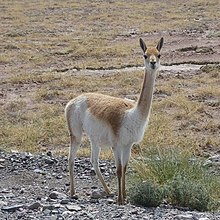The vicuña (Lama vicugna) or vicuna[3] (both /vɪˈkuːnjə/, very rarely spelled vicugna, its former genus name)[4][5] is one of the two wild South American camelids, which live in the high alpineareas of the Andes, the other being the guanaco, which lives at lower elevations. Vicuñas are relatives of the llama, and are now believed to be the wild ancestor of domesticated alpacas, which are raised for their coats. Vicuñas produce small amounts of extremely fine wool, which is very expensive because the animal can only be shornevery three years and has to be caught from the wild. When knitted together, the product of the vicuña's wool is very soft and warm. The Incavalued vicuñas highly for their wool, and it was against the law for anyone but royalty to wear vicuña garments; today, the vicuña is the national animal of Peru and appears on the Peruvian coat of arms.[6]
| Vicuña | |
|---|---|
 | |
| Vicuña in the Atacama Desert | |

